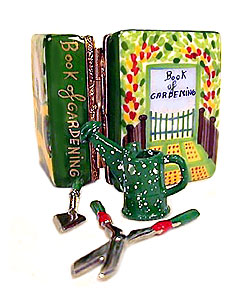Page Links
for
Kenny's
Garden Spot
Home
Flowers of
the Month
Poisonous
Plants
Gardening
Terms
Botanical
Names
Fertilizers
Plant
Nutrients
Shelf-Life
of
Veggie Seeds
Record-Size
Vegetables
Scoville
Heat Scale
for
HOT Peppers!
Hardiness
Zone &
Heat Zone
Maps
Temperature
Conversion
Table
Contact Me!


|
Gardening Terms

Below is a list
of Gardening Terms.
I will strive to
make it as complete as possible,
and
will be adding to this list often.
Hopefully it will be useful to us
all.
A
ACID
SOIL: soil having a pH below 7.0 and
containing no limestone
ACRE:
a measure of land totaling 43,560
square feet.
ALKALINE SOIL:
soil having a pH above 7.0, usually
found where limestone is present and/or
rainfall is sparse
ANNUAL: a plant that grows from
seed, matures, and produces seed all in
one year or season.
AQUATIC:
growing in or living in or upon the
water.
B
BIENNIAL:
a plant
that usually only lives two years,
usually producing flowers and seed the
second year.
BLANCHING: a
process of excluding light from a plant
to keep it from turning green. Usually
used on veggies like
endive,asparagus,cauliflower,& leeks
BLOOM: the
state or time of flowering; a flower or
blossom.
BLUFF: a high
steep bank or cliff.
BOG:
wet,spongy ground; small marsh or swamp.
BONE MEAL: a great
fertilizer used for its high phosphorus
content,usually upwards of 30 percent.
Most will also contain 1 to 2 percent
Nitrogen.
BOTANICAL NAME:
the latin or "scientific" name of a
plant,usually composed of two words,the
genus and the species.
BOTANY:
the
science that deals with plants, their
structure, growth, and
classifications.
BRAMBLE:
any prickly shrub of the rose family,
such as Blackberry, raspberry,
etc...
BULB: a term commonly
used for a whole category of
spring-or-summer-blooming perennial
plants.
C
CACAO:
a small evergreen tree grown in
tropical America; its seeds are used to
make Cocoa and Chocolate.
CALLA:
a plant of the arum family, with a
large white leaf surrounding a yellow
flower spike.
CAROTENE:
the yellow pigment found in many fruits
and vegetables, such as carrots, corn,
bananas,etc..Also the yellow found in
flowers such as Buttercups and
Daffodils. It changes into Vitamin A
once inside the body.
CATNIP: a plant of the mint
family with bluish flowers, Most cats
LOVE its scent.
CHARD: a
kind of beet whose large leaves and
thick stalks are very tasty.
CHICORY: a plant with blue flowers
whose leaves are used in salads.
CHIVE: an herb in the onion
family, with small, hollow leaves used
to flavor soups, stews, salads,etc...
CHLOROPHYLL: the green pigment
in leaves. When present and healthy
usually dominates all other
pigments.
COMPOSITE: a
large group of plants having flower
heads consisting of clusters of small
flowers.
COMPOST: a
mixture of decomposing elements used for
fertilizing soil.(A must for Gardeners)
CONIFER: a large group of
cone-bearing trees and shrubs,(mostly
evergreens).
COREOPSIS:
any of a group of plants of the
composite family, with daisy-like
flowers.
CORIANDER: a
European plant,(Herb) of the carrot
family.
CULM: the jointed
stem of various grasses, usually
hollow.
CUT-AND-COME-AGAIN:
a procedure used in harvesting in which
only leaves or stems are removed leaving
the plant and roots intact to remain
healthy.Used mostly in harvesting herbs
and leaf lettuce.
D
DAFFODIL: a spring flowering bulb
in the narcissus family with long,
narrow leaves and usually yellow or
white flowers.
DANDELION: a
common wild growing weed with yellow
flowers, and jagged, edible leaves.
DEAD-HEAD: the process of
pinching off used or spent blooms in
order for the plant to continue to bloom
continuously.
DECIDUOUS:
something that will shed its leaves
annually in the fall and/or winter.
DEHISCE: to burst open; as a seed
pod to discharge its contents.
DIBBLE: a pointed tool used to make
holes in the soil for seeds, bulbs, or
young plants.
DIOECIOUS:
plants that have flowers of only one sex
per plant.
DIVIDE: the
process of splitting up plants, roots
and all that have began to get bound
together. This will make several plants
from one plant and needs to be done to
mature perennials every 3 to 4
years.
DROUGHT: prolonged
dry weather.
DRUPE: a fruit with one or more seeds inside surrounded by fleshy membrane; peaches, plums, etc.
E
ENDOPHYTE: a plant that lives
inside the tissues of another plant
EPIPHYTE: a plant that grows on
another plant but gets its nourishment
from the air; an air plant.
EVERGREEN: having green leaves
throughout the entire year.
F
F1 HYBRID: a
first-generation hybrid produced by
cross-pollinating two compatible parent
plants.
FALLOW: land plowed
but not seeded for one or more seasons,
(to enrich soil and kill weeds).
FERTILIZE: to make fertile,
fruitful, and productive; to amend the
soil in order to improve the quality or
quantity of plant growth.
FORCE:
induce a plant to grow,bloom, or
set fruit out of its natural season
FRIABLE: term describing soil
that crumbles readily and is easy to
work
FROND: the leaf-like,
spore-bearing
organ of a fern; a particular type of
leaf, especially of the palm family.
G
GENUS: Group
of related plant species that share many
common characteristics and are believed
o have evolved from the same ancestor
GERMINATE:
to start developing or growing; sprout
or cause to sprout from seed.
GINSENG: an herb with a thick,
forked, aromatic root that is used
medicinally.
GRUB: to
clear ground of roots by digging them
up; uproot.
H HABITAT:
a native environment; where
something is ordinarily found.
HACKBERRY; an American tree of the
Elm family, with small cherrylike fruit.
HARDENING OFF:the process of
gradually acclimating greenhouse-or
indoor-grown plants to outdoor growing
conditions.
HARDINESS: the
ability of a plant to withstand low
temperatures without artificial
protection.
HARROW: a heavy
frame with spikes, used for leveling and
breaking up plowed ground and covering
seeds.
HARVEST: the
gathering of a crop; the time of year
when the crops are reaped and gathered.
HEELING-IN: Temporarily
planting a bare-root tree or shrub to
keep the roots from drying out until it
can be planted in its permanent location
HEMLOCK: a poisonous weed
of the carrot family, with small,white
flowers and finely divided leaves.
HERB: any seed plant whose stem
withers away annually: any such plant
used as medicine, seasoning, etc...
HUMUS: the brown or black
organic part of the soil,resulting from
the partial decay of leaves and other
matter.
HYBRID: the
offspring of two plants of different
species; anything of mixed origin.
HYDROPONICS: the science of
growing in mineral solutions instead of
in soil.
DON'T
FORGET TO
SIGN MY GUEST BOOK
I
INDEHISCENT: not opening at
maturity to discharge its seeds.
INDIGO: a plant of the pea
family that yields a blue dye, (dye is
also called Indigo).
INTERNODE:
that portion of the stem between
the places where two successive leaves
are attached.
L
LAUREL:
an evergreen tree or shrub with
large, glossy, aromatic leaves, (also
called the Bay Tree. ).
LEEK: a vegetable related to the
onion but of milder flavor, with long,
broad, succulent leaves.
LICHEN: a group of mosslike plants,
such as Algae and Fungi, that grows in
patches on rocks and tree trunks.
LOAM: a rich soil composed of
clay, sand, and organic matter; any
rich,dark soil.
LOBLOLLY:
a thick-barked Pine tree native to the
southern U.S. that is often found in or
around swamps.
LOCO-WEED:
certain plants of the pea family which
causes Loco-Disease in cattle that eat
it. (Found in western U.S.).
LOVE APPLE: what some people call
the tomato.
M
MESOPHYTE: a plant that grows
best in a moderately moist
environment.
MULCH: organic
or inorganic covering laid over garden
soil to discourage weeds and slow
evaporation of moisture from the
soil.
N
NATIVE
PLANT: a plant that occurs naturally
in a specific region or locality.
NEUTRAL: soil with a pH of 7.0,
that is neither acid nor alkaline.
NODE:
that part of a stem from which a
leaf starts to grow.
NUTRIENT:
any substance which a plant can use
as food.
O
OVULE: the part
of the plant which develops into a seed.
P
PERENNIAL: a
plant with a life cycle more than Two
years.
pH: a measurment of
soil's acidity or alkalinity.- 7.0 is
neutral, readings above 7.0 are alkaine,
and below 7.0 are acid.
PHOTOSYNTHESIS: the
formation of carbohydrates in plants
from water and carbon dioxide, by the
action of sunlight on the
Chlorophyll.
PISTIL: the
seed-bearing organ of a flower,
consisting of the ovary, stigma, and
style.
PITH: the soft,
spongy tissue in the center of certain
plant stems.
R
RECEPTACLE: that part of the
stalk from which the flower grows.
RELATIVE HUMIDITY: a measurement
of the amount of moisture in the
atmosphere.
RHIZOME: a
horizontal,rootlike stem under or along
the ground, which usually sends leafy
shoots from its upper surface.
S
SCION: a shoot or bud
of a plant, used for grafting.
SELF-POLLINATION: the process by
which a flower is fertilized by its own
pollen
SEPAL: any of the
leaf divisions of a plant
SPERMATOPHYTE: any seed-bearing
plant
STAMEN: a
pollen-bearing organ in a flower
STIGMA: the upper tip of the
pistil of a flower, receiving the
pollen.
T
TANNIN: the brown pigment found in
leaves and stems,usually the weakest of
all pigments and only visible in fall
and winter as other pigments have
left.
TENDRIL: a threadlike
part of a climbing plant, serving to
support it by clinging to an object
THATCH: layer of dead stems and
leaves that can build up at the base of
the turf in a lawn faster than the
material can decay- it hinders the
passage of water and fertilizers to the
soil beneath.
TOP-DRESS:
spread compost,fertilizers,or other
soil-enhancing material on top of the
soil around plants, without working the
material into the soil.
TUBER: a short, thickened,
fleshy part of an underground stem, (as
in a potato).
U
UMBEL:
a cluster of flowers with stalks of
nearly equal length which spring from
about the same point.
V
VARIEGATED: plant whose leaves
are irregularly marked with a second
color, most often yellow,ivory,or white
VERMICULITE:
lightweight,water-absorbent material
used in potting mixtures and
manufactored from heat-expanded mica.
W
WEED: any undesired,
uncultivated plant that grows where it
is not wanted,as to crowd out a desired
crop.
WHIP: a young,
unbranched tree.
If you have any suggesions,
PLEASE E-MAIL ME
with Image on left.

GOD
BLESS AMERICA



www.angelfire.com/pe/kennys/index.html
~ Copyright © 1999-2000-2001-2002-2003-2004-2005-2006-2007-2008-2009-2010 ~
|



